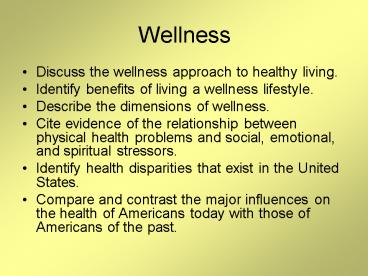Wellness PowerPoint PPT Presentation
1 / 21
Title: Wellness
1
Wellness
- Discuss the wellness approach to healthy living.
- Identify benefits of living a wellness lifestyle.
- Describe the dimensions of wellness.
- Cite evidence of the relationship between
physical health problems and social, emotional,
and spiritual stressors. - Identify health disparities that exist in the
United States. - Compare and contrast the major influences on the
health of Americans today with those of Americans
of the past.
2
Wellness (cont.)
- Identify and discuss the main wellness challenges
for Americans. - Identify obvious and subtle factors that help
shape behavior. - Discuss some of the underlying assumptions of
lifestyle change. - Identify and describe the six stages of change.
- Describe strategies that can be useful to
designing and implementing an action plan for
change.
3
Wellness
- The continuous, active process of becoming aware
of the different areas in ones life, identifying
the areas that need improvement and then making
choices that will facilitate attainment of a
higher level of health and well-being.
4
Past vs. Today
- Treatment instead of prevention
- Active in health care
- Exercise control over wellness (risk factors)
- Partners with health provider
- Individual responsible for wellness
5
Components of Wellness
6
Spiritual
- Is the belief in a source of value that
transcends the boundaries of the self but also
nurtures the self. - Grow, learn, meet new challenges
- Strong sense of values, ethics, morals
7
Social
- Having the ability to interact successfully with
people and ones personal environment. - Support vs. Non-support
8
Physical
- Ability to carry out daily tasks, develop
cardiorespiratory and muscular fitness, maintain
adequate nutrition and a healthy body fat level,
and avoid abusing alcohol and other drugs or
using tobacco products.
9
Emotional
- The ability to control stress and to express
emotions appropriately and comfortably. - Recognize and except feelings.
- Set backs and failures.
10
Intellectual
- The ability to learn and use information
effectively for personal, family, and career
development. - Behavior gap
- Locus of control
- Self-efficacy
11
Occupational
- The ability to achieve balance between work and
leisure time. - We dont live to work, we work to live.
12
Environmental
- The ability to promote health measures that
improve the standard of living and quality of
life in the community, including laws and
agencies that safeguard the physical environment. - Past vs. Present
- Health disparities
13
Integrating the 7 Components
- Body, mind, and spirit
- If one breaks down, the whole system is
threatened. - Illness and its mental, social, and spiritual
aspects - Negative feelings
- Psychosomatic diseases.
14
The Wellness Challenge
- Health problems today lifestyle diseases.
- Heart Disease, Cancer, and Stroke leading cause
of death in US. - Chronic Diseases heart disease, diabetes,
arthritis, hypertension. - Acute Illness appendicitis, pneumonia,
influenza.
15
Other Causes of Death
- (age 15-24) Accidents, homicide, and suicide.
77 motor vehicle deaths. - (age 25-44) Accidents, cancer, heart disease,
suicide, HIV, and homicide. - Negative lifestyle
16
12 Steps for Promoting Health and Improve the
Quality of Life
- Exercise regularly.
- Eat more fresh vegetables and fruits, high fiber
foods, and whole grains and drink more water. - Limit animal fat, cholesterol, and sodium in the
diet. - Supplement the diet with calcium and antioxidant
vitamins. - Pursue and maintain ideal body weight.
- Stop illegal drug use and abstain from or limit
alcohol consumption.
- Terminate smoking and use of smokeless tobacco.
- Avoid excessive sun exposure or wear sunblock.
- Fasten seat belts.
- Obtain good prenatal health care.
- Regularly have medical checkups and perform
self-exams. - Keep immunizations up-to-date.
17
Risk Factors Associated with Pre-mature Death and
Chronic Illness
- Cigarette Smoking 20 of all deaths and most
preventable. - Diet low in saturate fat and high in fruits,
vegetables, and grain products. - Sedentary Lifestyle less than 10 regular
vigorous activity, 25 5 or more days for 30
minutes, 25 do not partake in any regular
activity.
18
Achieving Lifestyle Change
- Behavior is learned.
- Obvious influences.
- Outside influences.
- Subliminal messages.
- Psychological need.
- Reactance motivation.
- Bad habits can be unlearned and new habits can be
learned.
19
Self Help Plan
- A self help approach assumes that individuals can
manage their lifestyle changes and can learn to
control those features in the environment that
are detrimental to health. - Successful lifestyle change is almost impossible
to achieve without a plan. - Page 13.
20
Six Stages of Change
- (Figure 1-4, page 14)
- Precontemplation
- Contemplation
- Preparation
- Action
- Maintenance
- Termination
21
Action Strategies
- Countering
- Avoidance
- Reminders
- Contracting
- Shaping up
- Support groups

